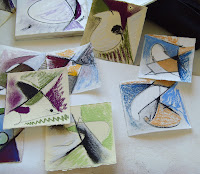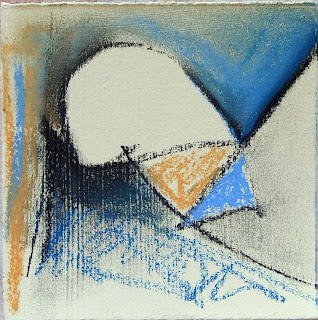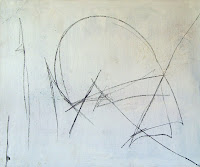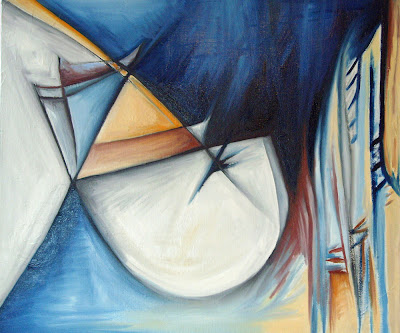
First, I sat down with my pastels, and some tiny pieces of paper I had torn up into these miniature squares. I stack them up next to me, take out the black charcoal pencil (number 4, if you really want to know), and do quick little drawings. It is important that the drawings are quick, because that's how I stay loose. I usually do between 6 and 9 of these little drawings. I line the drawings up where I can pick and choose, and then I begin to add color. This is where a lot of my experimenting comes in. It seems like the drawings usually get better as I go along, but of course nothing is set in stone. I try to get them all to a "complete" stage (these are only studies, after all, so I am not trying to finish them). Then, I choose a favorite. This will be the guide for the painting.

The canvas I used for this painting was already stretched and gessoed, ready to go. This saves a couple of days, for those of you who don't paint. I have this really black, messy charcoal that I use to do the preliminary drawing with. I am not worried about perfection here. The extra lines I draw to "find" the right proportions are lines that can be used, or not, later. This all depends on how I feel the composition is going as I get further along. Here you can see the charcoal drawing on my big canvas.

I have to admit, it was hard to remember to stop and take photos along the way! Harder than I thought it would be, that's for sure. I guess I was a little excited. I take my time, squeezing out the oil paints, and mixing colors. I have discovered that if I hurry here, the painting will suffer. I use this time to think about the relationship I want the colors to have, and to contemplate the feeling I am shooting for with the painting. I often have a word, or emotion in my mind when I start a painting. This one is really about the move, or more acurately, learning to bend with the wind. I am finding greater peace in bending whichever way I am being pushed (or led) by life.
I am always conscious of focusing on the dark and light areas. One of the things that I find exciting, visually, is having a big contrast between the dark and light areas of a painting. I like to start with the dark if I am working on a light ground, and start with the light, if the ground is dark. So the dark blue and black were painted first. I want the brushwork to have a lot of energy, so I am using big brushes, and rough brushstrokes initially.

At some point, I decided the colors were just not dynamic enough, so I began to add more color than I had initially planned on. I tend to turn the painting as I work, so that it forces me to work the whole painting at once. I want the painting to advance as a whole, rather than having one little area that I love, and the rest of the painting in shambles. I find turning the painting will help me with this. (Although it can be messy, since I usually paint the edges, too. That's just the price I pay, I guess.)

I have the little study for the painting taped up on the wall, right next to where I am working, so all I have to do is turn my head a little bit, and I can see it. With this in mind, remember that at some point, the large painting has to become its own work. There is always a departure from the original sketch, and sometimes letting go of that original idea is difficult.
I have now reached a point where if I were to continue working, the colors would get muddy looking. That is a sign that it is time to stop. (that, and my rumbling stomach!) So here is the painting in its last stage. There is a chance I may look at it tomorrow and find a section to rework. However, I need to let it dry before really working it again, if I want to keep the freshness. Since this is oil, it could take a week or two (or more!) for this to happen. So for now, I am done!




























